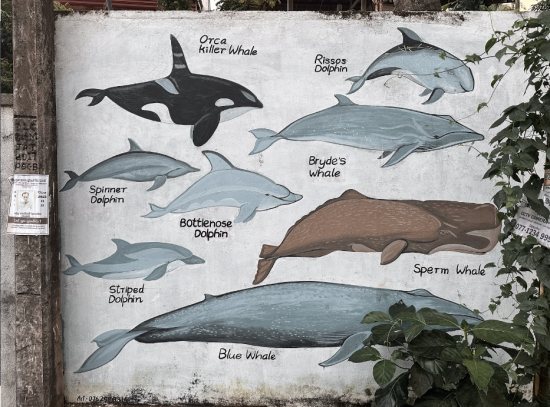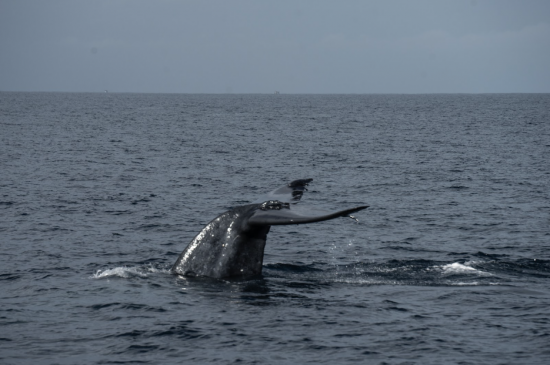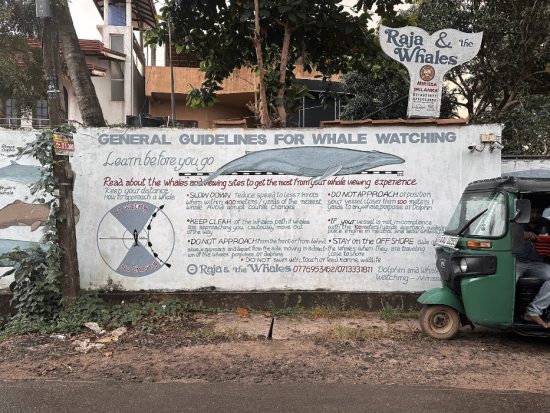







Off the coast of Mirissa, Sri Lanka, it felt like we had the whole ocean to ourselves. It was barely 6am as the sun began to creep its way over the horizon, and our small charter vessel was headed to a place known as Dondra Point, where the continental shelf meets the deep ocean.
We were headed to this junction of the shallows and the deep to seek out one of the largest and most awe inspiring creatures on Earth: the blue whale. While I sat on the vessel that morning at the very start of whale watching season, I was feeling equal parts excitement, fascination and general discomfort.
Spotting blue whales is a challenge even on a good day at sea, one with calm conditions. Unlike humpbacks who breach, play and are known for their strong sense of curiosity, blue whales are elusive, shy and typically weary of human interactions. You’ll very rarely see a blue whale extend its body far out of the water, partly because of its size and because it’s not in their nature.
This all being said, trying to spot a blue whale through the traditional whale watching methods is fairly uncommon and reserved only for a lucky few ocean-goers. Blue whales are usually found in deeper waters, which makes the whale watching opportunities few and far between. However, Sri Lanka has a steep drop off and they use these waters year round, increasing the chances of a spotting.
These magnificent creatures, which can reach lengths of up to 30 meters (100 feet) and weigh as much as 200 tons, are drawn to the region's rich feeding grounds, abundant in shrimp. The cold, nutrient rich waters, or upwellings, of Sri Lanka create more productive feeding grounds for blue whales than other warmer waters, which has given Sri Lanka a reputation for its special blue whale activity.
There are close to 100 whale watching operators that take people out to experience these behemoths in the wild. However, of these 100, only 4 are said to be following best practices, at least according to our research and the insights of the science-backed teams who call this country their home. Only 4 operators are considering the health and well-being of the whales they are viewing by keeping their distance and adhering to the advice published on how to tour responsibly.
So, as excited as we were to potentially see blue whales, we also knew that we’d be seeing the other side of things. The not so nice side of things. We’d be seeing over tourism in its darkest form.
Upon arriving for our venture in whale watching, we met Dr. Asha de Vos, the Founder & Executive Director of Oceanswell and fellow Explorer Club member, based in Colombo. She’s the leading authority on this particular population of blues here in Sri Lanka if not the world. Fascinated with science from a young age, her first whale encounter unlocked the door to the rest of her life, and since, she’s been relentless in her pursuits to keep these animals, among other whale species, safe.
Blue whale tourism in Sri Lanka, although only a few decades old, presents both opportunities and challenges. This burgeoning industry is a valuable source of income and awareness for local communities and operators. However, its impact on the marine environment and whale behavior is still not fully understood. Many former fishermen have transitioned to the whale watching industry, offering a sustainable alternative to overfishing. However, it's essential that they are equipped with knowledge of sustainable practices to avoid creating new problems.
Oceanswell, an organization focusing on marine conservation, emphasizes the importance of responsible tourism practices. Dr. Asha explained that she and her team scrutinize everything from tourist advertising to surveys, aiming to manage tourist expectations and prevent negative wildlife encounters. Misleading advertisements, like photoshopped images of breaching whales, can set unrealistic expectations, influencing tourist behavior and potentially leading to harmful interactions with wildlife.
Dr. Asha talked about the shift towards selling broader ocean experiences rather than targeting the allure of sighting a specific species. This is what she thinks can reduce the pressure on individual animals and the disappointment of tourists if they don’t encounter the one they came to see. Unfortunately, she said that some tourists find blue whale watching less exciting compared to more active species like humpbacks, leading to a phenomenon known as 'tickbox tourism,' where the focus is more on capturing a moment for social media rather than a genuine interest in marine life.
In our conversation, Dr. Asha made it clear that tourists bear a significant responsibility in choosing ethical operators and adhering to wildlife viewing regulations. Uneducated or indifferent tourist behaviors can incentivize operators to engage in illegal and harmful practices, such as swimming with whales, which is both dangerous and illegal. This rush to provide tourists with a close encounter can lead to unsafe situations, with ignorant and overeager travelers hastily entering the water near large animals and moving boats.
However, the greatest threats to blue whales in Sri Lankan waters are ship-strikes and entanglement in fishing nets. We learned from Dr. Asha that, due to their immense size, freeing them from nets is a daunting task. An additional threat to the whales also comes from a surprising source: noise pollution. The whales communicate through complex, “whale song,” essential to their survival and breeding but also easily disrupted by the hum of human activity in the very same waters.
Oceanswell also addresses the issue of illegal fishing and the lack of effective policy implementation. Education is key to ensuring that local communities understand and comply with marine protection regulations. The organization advocates for equitable ocean management, opposing “parachute science”, where local experts are underutilized or not credited for their knowledge on these ocean issues that are sitting right at their doorstep.
Whales have always been my favorite marine animal, without a question. Since I was a child, they’ve been the center of my obsession. Like Dr. Asha, I’ve dreamed of being among these incredible creatures and more recently, I’ve dreamt of diving with them. However, I must admit I wasn’t truly well versed on the repercussions of pursuing this kind of diving experience.
It wasn’t until I stumbled upon a long read by the legendary Doug Seifert (Editor of DIVE Magazine) called “In the company of giants: diving with the blue whales of Sri Lanka,” which opened my eyes to the reality of diving with whales. And before learning more intimately on the subject, I had always thought this country was KNOWN for legal diving with whales.
Since putting a focus on conscious exploration, and learning from others like Dr. Asha and Oceanswell who have spent careers studying the implications of human activity on wildlife, my perspective has shifted dramatically on the matter. Diving with whales in Sri Lanka is considered illegal without a government official permit, yet operators will sell tours for $100-200 USD per person on the beaches of Mirissa to take tourists out to get in the water.
Although this is widely known, authorities turn a blind eye—as tourism money takes precedent unfortunately. In our case, we even saw a Sri Lankan Navy vessel running its own tourist whale watching operation during the start of peak season!
Whale watching standards and regulations are being set, but rarely being upheld.
This was happening when Doug wrote his piece in 2020, and I can assure you that it is still happening now at the end of 2023. Something is in need of a change. The wild isn’t a place for us to exploit. Taking some selfies in the water and checking off that “you did it” is far from sustainable or the right thing to do when it comes to interacting with an endangered species. Blue whales have been hunted, tracked and chased for centuries. Human interference hasn’t let up; their populations around the world are shrinking and their discomfort around humans is increasing.
We saw this first hand while watching out to sea. Keeping our distance as the only boat on the water, a gigantic, pregnant female swam around us. Continuing to surface, she seemed calm. For the next 30 minutes, she came up over and over. It wasn’t until the fleet of tour boats came pushing through full steam ahead that the whale started to dive down deep, lost to the vastness of the sea. It was clear she’d seen this all before and wasn’t having it.
There’s the pros and cons of whale watching. When not following the best practices, the animal is put in danger. We impact its environment and damage its equilibrium. But when regulations are followed, those established by the local experts who study these animals day in and out, there’s a way to coexist and bring people closer to the wonders of the ocean. The more connections we can forge between humans and marine life, the better. But it must be done sustainably.
When choosing to explore consciously, it means we need to do our homework in understanding who to align with and what the rules of the land/sea look like. We can’t go to far off places only to disregard their rules, regulations and customs—as we wouldn’t do that on our own home turf. Respecting the natural world and communities we visit, no matter where we are, is the foundation of conscious exploration.
It was hard to watch as 10 speeding vessels came right over and on to the whale, desperate to please their eager customers onboard. The team who took us out discussed how many people tell them they aren’t satisfied with the tour experience, even when seeing multiple blue whales in the wild. They weren’t close enough, it all happened too fast, or they didn’t get their perfect selfie.
Humans have been impacting whale species for far too long. But with new leaders taking a stand, primed by renowned scientists, there’s hope for the future.
Dr. Asha's personal experiences with parachute science have driven her to champion local expertise and promote research leadership within Sri Lanka. She advocates for exploring and understanding one's own environment, recognizing that locals have deeper insights and connections with regional issues. Her approach emphasizes training and education to empower the next generation with confidence and the belief that they deserve a prominent role in scientific research and conservation.
A key aspect of Dr. Asha's work is the empowerment of local communities. She believes in the immense value of building local capacity, often preferring to train individuals from diverse backgrounds, like IT, in marine biology, rather than relying on external experts. This approach not only fosters local expertise but also ensures that the research and conservation efforts are more attuned to the specific needs and nuances of the region.
Dr. Asha is dedicated to helping people on the ground publish their work and gain recognition for their contributions. Her efforts extend to inspiring young people to pursue careers in marine science and conservation, especially when it comes to the protection of whales in Sri Lanka. She creates opportunities for students to take ownership of small projects, which fosters a sense of responsibility, leadership and drive to fight for a more sustainable future.
“You don’t need to be a marine biologist to contribute meaningfully to marine conservation,” Dr. Asha said. “What you do need is to figure out how your unique skills can connect a broader population to nature and environmental issues, ultimately playing a vital role in the larger effort to protect and preserve our planet. One example being in redefining the marketing standards around whale watching in Sri Lanka,” she continued on.
The good news is there’s a lot of people we’ve met along the way who are doing something about this. Whales of all kinds are a focal point, as they have historically been the symbol of conservation since the birth of the movement itself. To do our part, we have to be smarter and more discerning customers. We need to demand that conservation efforts equate to sales. If we say we want better and safer practices instilled or we simply won’t buy tours, then the industry must shift to accommodate the voices of its demand.
When conservation becomes the selling point instead of instant gratification, we’re one step closer to the sustainable future many of us crave.
We were extremely thankful to have met Dr. Asha, along with the many other ocean advocates throughout our three weeks in Sri Lanka. This was one of the most dedicated, passionate and committed groups of people in and out of science, fighting for their own backyard. There’s something to be said for defending where you come from and gaining the expertise to champion a future where conservation is the cornerstone of tourism.
 Andi
Andi 28th May 2024
28th May 2024